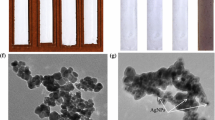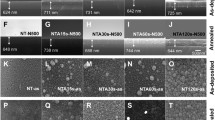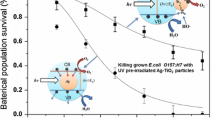Abstract
In this study, both suspensions and thin films of TiO2 and silver loaded TiO2 (Ag-TiO2) were used in the photocatalytic degradation/disinfection of C. albicans. In the case of thin films coated materials, both microscope slides and steel pieces of similar dimensions were dip coated using sol–gel solutions prepared from titanium isopropoxide. Surface analysis of the materials confirmed that thin film formation had been succesful. After set periods of irradiation in the presence of suspension or thin film coated material, 10 μL aliquots of the solution were withdrawn and directly cultivated on sabouraud dextrose agar for 24 h at 37 °C. The number of living colonies was counted. The results show that both the suspensions and the thin films displayed superior antimicrobial properties towards C. albicans. In particular the Ag-TiO2 catalyst was extremely active even in the dark, for disinfection of C. albicans. The degradation percentage over TiO2 and Ag-TiO2 thin films coated on the steel substrate was higher than those coated on glass achieving 80 and 97.9%, respectively, using the 365 nm, near visible region light source.










Similar content being viewed by others
References
Cihlar RL, Calderone RA (2009) Methods in molecular biology, vol 499. Humana Press, New York
Blake DM, Maness PC, Huang Z, Wolfrum EJ, Huang J, Jacoby WA (1999) Application of the photocatalytic chemistry of titanium dioxide to disinfection and the killing cancer cells. Sep Pure Meth 28:1–50
Carp O, Huisman CL, Reler A (2004) Photoinduced reactivity of titanium dioxide. Prog Solid State Chem 32:33–177
Mills A, Lepre A, Elliott N, Bhopal S, Parkin IP, O’Neill SA (2003) Characterization of the photocatalyst Pilkington Activ (TM): a reference film photocatalyst? J Photochem Photobiol A 160:213–224
Page K, Palgrave RG, Parkin IP, Wilson M, Savinc SLP, Chadwickc AV (2007) Titania and silver–titania composite glass films on glass–potent antimicrobial coatings. J Mater Chem 17:95–104
Wolfrum EJ, Huang J, Blake DM, Maness PC, Huang Z, Fiest J (2002) Photocatalytic oxidation of bacteria, bacterial and fungal spores, and model biofilm components to carbon dioxide on titanium dioxide–coated surface. Environ Sci Technol 36:3412–3419
Sun SQ, Sun B, Mang WQ, Wang D (2008) Preparation and antibacterial activity of Ag-TiO2 composite film by liquid phase deposition (LPD) method. Bull Mater Sci 31:61–66
Machida M, Norimoto K, Kimura T (2005) Antibacterial activity of photocatalytic titanium dioxide thin films with photodeposited silver on the surface of sanitary ware. J Am Ceram Soc 88:95–100
Erkan A, Bakır U, Karakaş G (2006) Photocatalytic microbial inactivation over Pd doped SnO2 and TiO2 thin films. J Photochem Photobiol A 184:313–321
Sökmen M, Candan F, Sümer Z (2001) Disinfection of E-coli by the Ag-TiO2/UV system: lipidperoxidation. J Photochem Photobiol A 143:241–244
Sunada K, Watanabe T, Hashimoto K (2003) Studies on photokilling of bacteria on TiO2 thin film. J Photochem Photobiol A 156:227–233
Lonnen J, Kilvington S, Kehoe SC, Al-Touati F, McGuigan KG (2005) Solar and photocatalytic disinfection of protozoan, fungal and bacterial microbes in drinking water. Water Res 39:877–883
Theron J, Walker JA, Cloete TE (2008) Nanotecnology and water treatment: applications and emerging opportunities. Crit Rev Microbiol 34:43–69
Seven O, Dindar B, Aydemir S, Metin D, Özinel MA, Içli S (2004) Solar photocatalytic disinfection of a group of bacteria and fungi aqueous suspensions with TiO2, ZnO and Sahara desert dust. J Photochem Photobiol A 165:103–107
Chen FN, Yang XD, Wu Q (2009) Photocatalytic Oxidation of Escherischia coli, Aspergillus niger, and formaldehyde under different ultraviolet irradiation conditions. Environ Sci Technol 43:4606–4611
Petrov L, Iliev V, Eliyas A, Tomova D, Puma GL (2007) Photocatalytic properties of modified TiO2 coatings for purification of waste water and air. Protec Ecol 8:881–909
Chen X, Mao SS (2007) Titanium dioxide nanomaterials: synthesis, properties, modifications and applications. Chem Rev 107:2891–2959
Bartnicki-Garcia S (1973) A fundamental aspects of hyphal morphogenisis, microbial differentiation. In: Ashworth JM, Smith JE (eds). Cambridge University Press, London
Mitoraj D, Janczyk A, Strus M, Kisch H, Stochel G, Heczko PB, Macyk W (2007) Visible light inactivation of bacteria and fungi by modified titanium dioxide. Photochem Photobiol Sci 6:642–648
Kühn KP, Chaberny IF, Massholder K, Stickler M, Benz VW, Sonntag HG, Erdinger L (2003) Disinfection of surfaces by photocatalytic oxidation with titanium dioxide and UVA light. Chemosphere 53:71–77
Chaffin WL, Lopez-Ribot JL, Casanova M, Gozalbo D, Martínez JP (1998) Cell wall and secreted proteins of Candida albicans: identification, function, and expression. Microbiol Mol Biol Rev 62:130–150
Kiwi J, Nadtochenko V (2005) Evidence for the mechanism of photocatalytic degradation of the bacterial wall membrane at the TiO2 interface by ATR-FTIR and laser kinetic spectroscopy. Langmuir 21:4631–4641
Kondo MM, Jardim WF (1991) Photodegradation of chloroform and urea using Ag-loaded titanium dioxide as catalyst. Water Res 25:823–827
Butkus MA, Talbot M, Labare MP (2005) Feasibility of the silver-UV process for drinking water disinfection. Water Res 39:4925–4932
Acknowledgments
This work was financially supported by Turkish Research Council (TUBITAK, Grant Number 107T853) and Karadeniz Technical University (BAP, Grant Number 2007-111-0028). We would like to thank all the staff in the Materials and Engineering Research Institution (MERI) at Sheffield Hallam University for technical assistance and personal help.
Author information
Authors and Affiliations
Corresponding author
Rights and permissions
About this article
Cite this article
Tatlıdil, İ., Sökmen, M., Breen, C. et al. Degradation of Candida albicans on TiO2 and Ag-TiO2 thin films prepared by sol–gel and nanosuspensions. J Sol-Gel Sci Technol 60, 23–32 (2011). https://doi.org/10.1007/s10971-011-2546-0
Received:
Accepted:
Published:
Issue Date:
DOI: https://doi.org/10.1007/s10971-011-2546-0




